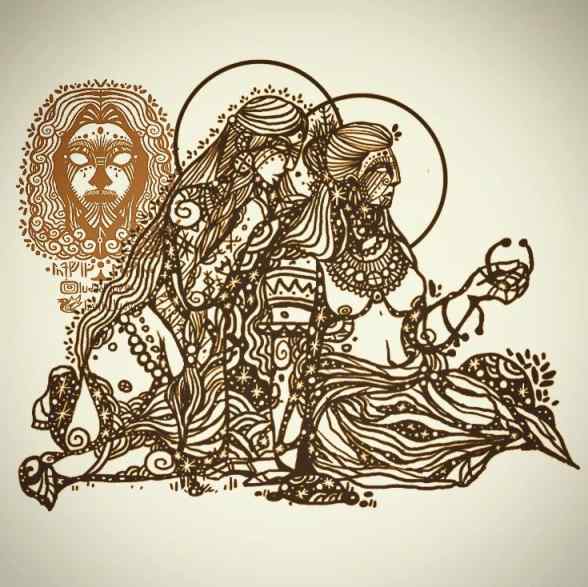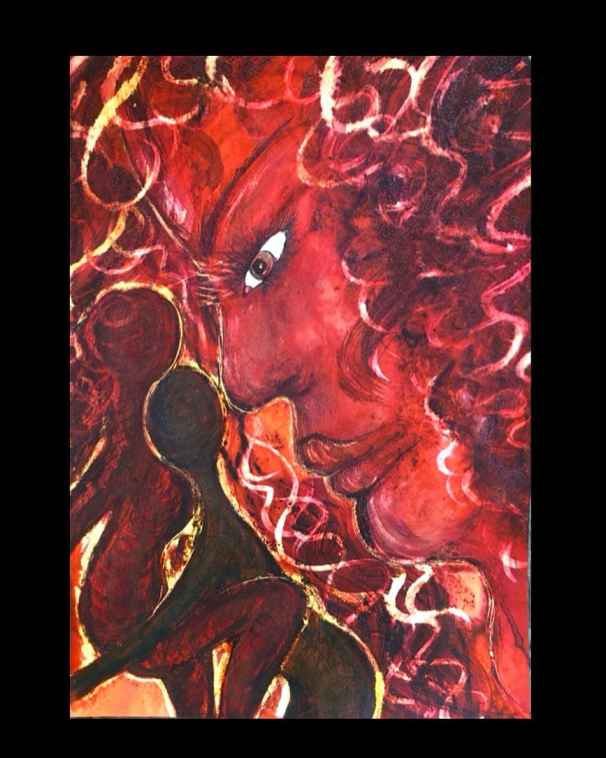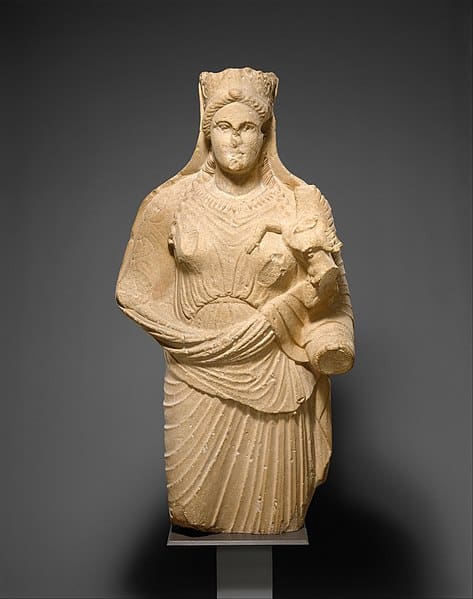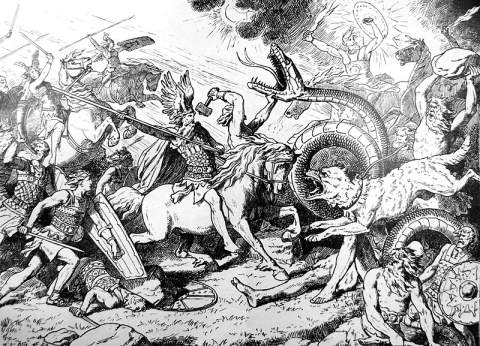In the pantheon of Norse gods and goddesses, Lofn stands out as a lesser-known yet intriguing deity. Often overshadowed by the likes of Frigg or Freyja, Lofn’s story is a testament to the depth and richness of Norse tales. She is the goddess of forbidden love which she might hello with her divine intervention.
Lofn Key Facts
| Parents | Unknown |
| Partners | None known |
| Siblings | Not specified |
| Offspring | None |
| Tribe | Aesir |
| Old Norse name | Lofn |
| Other names | Loven |
| The God of | Forbidden Love |
| Ass. Animal | Dove |
Name and Etymology
In the intricate world of Norse mythology, the name “Lofn” holds a special resonance. Derived from Old Norse, the term [ˈlovn] can be translated to mean “comforter,” “the mild,” or even “loving.” This etymology beautifully encapsulates her essence as a deity who stands as a beacon of love and solace. The Gylfaginning, a pivotal section of the Prose Edda, sheds light on the significance of her name. It suggests that the very concept of “love” in Norse culture is named after Lofn. Furthermore, it implies that if something was profoundly desirable to men, it could be referred to as “lofn,” underscoring her deep-rooted influence in the hearts and minds of the Norse people.
Ancient roots
While Lofn’s name is deeply embedded in Norse traditions, tracing her origins to older mythologies like the Germanic or Gothic tales remains a challenge. However, the universal theme of a deity overseeing love, especially forbidden love, is prevalent across various ancient cultures, hinting at humanity’s age-old fascination with such narratives.
Lofn Origins and Family
Lofn’s place in the Norse pantheon is both intriguing and enigmatic. As a member of the Aesir tribe, one of the two primary groups of deities in Norse mythology, she holds a distinctive position. However, the details surrounding her lineage and early life remain shrouded in mystery. Ancient texts provide limited information about her parentage, making her one of the more elusive figures in Norse tales.

Despite the ambiguity surrounding her origins, Lofn’s role in the myths is undeniable. Her affiliation with forbidden love suggests a deep understanding of the complexities of relationships, even if specific romantic liaisons or significant connections aren’t detailed in the myths. While many gods and goddesses have their families and relationships explicitly outlined, Lofn’s tales focus more on her divine interventions and less on her personal ties, adding to her enigmatic nature.
Lofn Roles And Responsibilities
Lofn’s role in Norse mythology is both tender and powerful. Listed as the eighth Asynjur (Aesir goddess) in the Gylfaginning, her essence is beautifully captured in the ancient texts. Described as kind-hearted and benevolent, she stands as a beacon of hope for those in love. The Gylfaginning, a pivotal section of the Prose Edda, highlights her unique position among the gods.
It states that Lofn has the special permission from either Alfather (Odin) or Frigg to unite men and women, regardless of the challenges or obstacles they might face. This divine endorsement underscores her significance in the pantheon, as she has the authority to override even the most stringent societal norms or divine decrees. It’s no wonder that the very concept of “love” in Norse culture is named after her, emphasizing her profound influence on matters of the heart.
Modern Goddess for LGBTQ+
In contemporary times, Lofn’s legacy has evolved, and she has become a symbol of love in all its forms. With the rise of LGBTQ+ rights and recognition, Lofn has been embraced by many as a goddess who champions love beyond traditional boundaries. Her ancient role of blessing forbidden unions resonates deeply with those who have faced societal barriers in their relationships. Today, she is celebrated as a divine ally for all lovers, reinforcing the idea that love, in all its manifestations, is sacred and worthy of divine protection.
Depiction And Characteristics

Lofn was often portrayed as a gentle and compassionate deity. Her actions in the myths highlight her empathy and understanding of human emotions. While she might not have been as powerful or fearsome as some of her Aesir counterparts, her influence was profound, touching the lives of countless mortals and immortals alike.
Lofn Symbols, Artifacts or Animals
When reading about Norse mythology, I’ve often come across the association of Lofn with the dove. This gentle bird, symbolizing love and peace, seems a fitting emblem for a goddess who oversees matters of the heart. However, as I delved deeper into the ancient texts, I couldn’t find concrete evidence linking Lofn directly to the dove.
It’s a curious thing about myths; they evolve and adapt over time. While many deities in the Norse pantheon have clear animal associations that provide insights into their nature and roles, some connections remain elusive. I’ve come to realize that, over the centuries, certain details about gods and goddesses might become obscured or even lost. Oral traditions, passed down through generations before being recorded by historians and scholars, can undergo subtle changes, with some nuances added and others fading away.
For some deities, like Lofn, these associations remain speculative. It’s a testament to the fluidity of myths and how they resonate differently across eras. While the dove’s association with Lofn might not be anchored in ancient lore, it serves as a bridge, connecting her timeless essence with our contemporary understanding.
Play Fun Norse Quiz
Is this article making you even more curious about Norse gods and goddesses? You can satisfy your curiosity by playing a fun Norse mythology quiz. This way, you can test your knowledge about Norse gods and goddesses, as well as fill in some gaps. Good luck and have fun playing!
Don’t forget to try our other games as well!
Lofn and Aphrodite – Goddesses of Love
When we delve into the world of mythology, it’s fascinating to draw parallels between deities from different pantheons. Lofn, the Norse goddess of forbidden love, and Aphrodite, the Greek goddess of love and beauty, offer a compelling comparison.

At first glance, both goddesses embody the essence of love, albeit in slightly different capacities. Lofn, with her gentle nature, oversees and blesses unions that face societal or divine barriers. She stands as a beacon of hope for those whose love defies conventions. Aphrodite, on the other hand, represents not just love but also beauty, passion, and procreation. Her tales are filled with romantic escapades, jealousies, and the intricate dynamics of relationships.
Now, when it comes to symbols, Aphrodite has a clear association with doves. These graceful birds are frequently seen in depictions of her, symbolizing love, purity, and peace. The dove’s connection with Aphrodite is well-documented in ancient Greek art and literature. In contrast, as I’ve mentioned earlier, the association of Lofn with doves is more speculative. While many modern interpretations link her with this bird, I couldn’t find concrete evidence of this in the ancient Norse texts. It’s intriguing to think that the dove, so closely tied to Aphrodite, might also be linked to Lofn, albeit in a more contemporary context.
Another point of contrast lies in their origins. While Lofn’s beginnings are shrouded in mystery, Aphrodite’s birth is a tale of drama and spectacle. According to Greek myths, she emerged from the sea foam, born from the severed genitals of Uranus, the sky god. However, this is almost always the case when comparing Norse and Greek mythologies. Although the ancient Greeks and their mythology predates the Norse with almost a couple of thousand years, it’s much better known today.
Myths about Lofn
Lofn’s myths primarily revolve around her interventions on behalf of lovers facing obstacles. One such tale recounts how she helped a mortal woman and an elf prince unite, despite their families’ vehement opposition.
Lofn Role in Ragnarok

Ragnarok, the cataclysmic end of the world in Norse mythology, saw the demise of many gods. Lofn’s fate during this tumultuous event remains uncertain. Some texts suggest she survived, continuing her role in the new world, while others remain silent on her fate.
Mentions in Ancient Texts
Prose Edda
Gylfaginning
In chapter 5, verse 36 of the Gylfaginning, High offers descriptions of 16 ásynjur, with Lofn being the eighth. This section provides a significant insight into her character and role. The text reads:
“The eighth is Lofn, who is kind and good to those who call upon her, and she has permission from Alfather or Frigg to bring together men and women, no matter what difficulties may stand in the way; therefore “love” is so called from her name, and also that which is much loved by men.”
Skáldskaparmál
The Skáldskaparmál is another crucial source in the Prose Edda that mentions Lofn. In this book, she is listed among 16 ásynjur names. Further, Lofn is highlighted in a kenning for “woman” crafted by the skald Ormr Steinþórsson. Beyond this specific mention, Lofn’s name is frequently used as a base word in skaldic kennings for “woman.”
Poetic Edda
Lofn, despite her significance in the Prose Edda, isn’t attested in any of the poems traditionally associated with the Poetic Edda. This absence is intriguing. Given her role and the depth of Norse mythology, it seems improbable that she wasn’t mentioned in any poetic narratives. It’s possible that Lofn was once a part of these poems, offering insights into her character and tales. However, if such poems existed, they have sadly been lost to time.
The ebb and flow of history, combined with the oral tradition of early Norse tales, means that some stories might have faded before they could be documented. It’s a poignant reminder of the transient nature of myths and the importance of preserving them for future generations.
Frequently Asked Questions
Lofn is the Norse goddess of forbidden love, often intervening to help lovers facing opposition.
Lofn is a member of the Aesir tribe.
Yes, Lofn is briefly mentioned in the Prose Edda, highlighting her role in blessing illicit unions.
The dove is often linked to Lofn, symbolizing love and peace.
Lofn’s name in Old Norse relates to “comfort” or “consolation.”
It’s uncertain. Some texts suggest she did, while others remain silent on her fate.
Featured Image Credit: Internet Archive Book Images, No restrictions, via Wikimedia Commons
